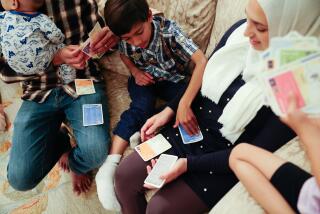Teaching by Example : While the holidays can help instruct children about tolerance, experts say it’s best learned in everyday behavior.
- Share via
The holidays may seem like a natural time to teach children the basics of tolerance. On many streets, blue and white light displays stand next to the red and green, stimulating children to ask about the celebrations of other families.
While there are useful ways to use such questions as a stimulus to discuss the historic richness of other religions, experts say tolerance is actually taught to children primarily through the adult behavior and conversation they witness every day.
“Tolerance is very difficult to teach,” said Dee Shepherd-Look, a clinical psychologist and psychology professor at Cal State Northridge. “It’s learned mostly by watching their parents treat and talk about people who are different.”
Most children identify closely with their parents and tend to develop attitudes about politics and religion that are similar to their adult models’--at least until mid-adolescence, Shepherd-Look said.
Children are especially attentive to the way people talk about other cultures and to the underlying messages in jokes that have racial or ethnic overtones.
“Parents have to be mindful all the time of what they are conveying,” said Gerald Margolis, director of the Museum of Tolerance in West Los Angeles. “Children are keen observers.”
Bryan Woken, pastor at the Shepherd of the Valley Lutheran Church in West Hills, said parents need to define what they would like their children to understand about their own world view and religion. The risk some parents take in thinking about their personal perspective is that they often discover they do not have a faith of their own, or have not spent much time considering their beliefs.
“Then the parents really have to make that journey first, on their own,” Woken said. Margolis, too, said parents who are interested in fostering tolerance in their children need to first examine their own attitudes and comfort levels regarding the variety of populations that live in Los Angeles.
Parents need to create “points of engagement”--ways in which the children can actually work with others from different cultures in a meaningful way. Doing something together is far more valuable than just walking through an art exhibit featuring work by those of a different culture.
*
The best way to give children such opportunities for real-world contact is to find ways they can work together on a project with a mutual goal, Shepherd-Look said.
She suggests that parents encourage children to invite friends of diverse backgrounds over to play and try to find scouting groups or other community activities that will offer meaningful time with others.
Woken suggests that parents ask their friends who acknowledge holidays different from theirs to include the family in their celebrations when they can.
*
Children who have long celebrated Christmas can appreciate the lighting of the menorah and playing dreidel games, for example.
But he warns that in sharing traditions, some families may find they have so secularized their holiday festivities that they are left with little that explains their religious base.
Shepherd-Look also suggests that parents provide explicit teaching about others, including taking their children to places such as the Museum of Tolerance, and specifically pointing out the common goals that all humans share.
She also recommends giving children cross-cultural toys, such as dolls representing other ethnicities, or board games based on the world’s geography and divergent cultures. But none of these approaches is a quick fix for incipient intolerance, she said.
When children do express a lack of tolerance, Shepherd-Look suggests parents try to help them feel empathetic to the other person’s perspective or situation.
The root of intolerance in children is often based in their own insecurity, she said, and studies have shown that children with high self-esteem are more tolerant of others.
More to Read
Sign up for Essential California
The most important California stories and recommendations in your inbox every morning.
You may occasionally receive promotional content from the Los Angeles Times.










